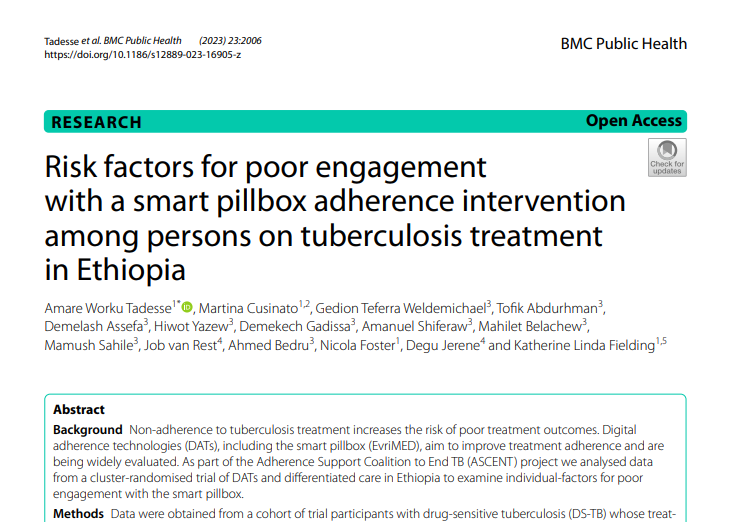Amare Worku Tadesse, Martina Cusinato, Gedion Teferra Weldemichael, Tofik Abdurhman, Demelash Assefa, Hiwot Yazew, Demekech Gadissa, Amanuel Shiferaw, Mahilet Belachew, Mamush Sahil, Job van Rest, Ahmed Bedru, Nicola Foster, Degu Jerene, Katherine Linda Fielding
Non-adherence to tuberculosis treatment increases the risk of poor treatment outcomes. Digital adherence technologies (DATs), including the smart pillbox (EvriMED), aim to improve treatment adherence and are being widely evaluated. As part of the Adherence Support Coalition to End TB (ASCENT) project we analysed data from a cluster-randomised trial of DATs and differentiated care in Ethiopia to examine individual-factors for poor engagement with the smart pillbox.
Data were obtained from a cohort of trial participants with drug-sensitive tuberculosis (DS-TB) whose treatment started between 1 December 2020 and 1 May 2022, and who were using the smart pillbox. Poor engagement with the pillbox was defined as (i) > 20% days with no digital confirmation and (ii) the count of days with no digital confirmation, and calculated over a two evaluation periods (56-days and 168-days). Logistic random effects regression was used to model > 20% days with no digital confirmation and negative binomial random effects regression to model counts of days with no digital confirmation, both accounting for clustering of individuals at the facility-level.
Among 1262 participants, 10.8% (133/1262) over 56-days and 15.8% (200/1262) over 168-days had > 20% days with no digital confirmation. The odds of poor engagement was less among participants in the higher stratum of socio-economic position (SEP) over 56-days. Overall, 4,689/67,315 expected doses over 56-days and 18,042/199,133 expected doses over 168-days were not digitally confirmed. Compared to participants in the poorest SEP stratum, participants in the wealthiest stratum had lower rates of days not digitally confirmed over 168-days (adjusted rate ratio [RRa]:0.79; 95% confidence interval [CI]: 0.65, 0.96). In both evaluation periods (56-days and 168-days), HIV-positive status (RRa:1.29; 95%CI: 1.02, 1.63 and RRa:1.28; 95%CI: 1.07, 1.53), single/living independent (RRa:1.31; 95%CI: 1.03, 1.67 and RRa:1.38; 95%CI: 1.16, 1.64) and separated/widowed (RRa:1.40; 95%CI: 1.04, 1.90 and RRa:1.26; 95%CI: 1.00, 1.58) had higher rates of counts of days with no digital confirmation.
Poorest SEP stratum, HIV-positive status, single/living independent and separated/ widowed were associated with poor engagement with smart pillbox among people with DS-TB in Ethiopia. Differentiated care for these sub-groups may reduce risk of non-adherence to TB treatment.
